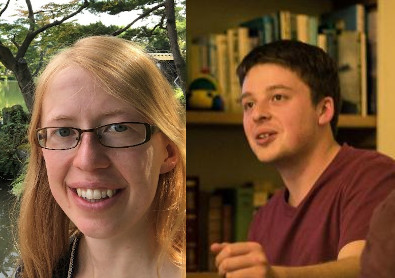AU researchers win prestigious European Research Council grants
Two cosmologists in the Astronomy Unit in the School of Physics and Astronomy have been awarded prestigious Starting Grants from the European Research Council.

ERC Starting Grant winners Dr Tessa Baker and Dr Phil Bull.
Dr Tessa Baker and Dr Phil Bull will receive a total of over €3 million to help them start their own research groups, providing support for postdocs, PhD students and equipment. Out of 432 awardees — from over 3000 applications — throughout Europe and associated states, only 14 grants were awarded in astrophysics, so this represents a significant endorsement of world-leading research in astronomy at Queen Mary.
Commenting on the award Dr Tessa Baker, Royal Society University Research Fellow, said: “I’m really thrilled with the award - it will enable me to build my own research group here at Queen Mary, and play a role in the exciting new field of gravitational wave astronomy.”
Dr Phil Bull, Lecturer in Cosmology, added: “The timing of this award really couldn’t be better. We’re about to start receiving a deluge of data from a pair of cutting-edge radio telescopes in South Africa. This support from the ERC will allow me and my research group to really dig into it and start making what we hope will be really fascinating maps of the cosmos that show how it evolved over time.”
“This is a phenomenal achievement for Tessa and Phil” says the Head of the Astronomy Unit, Dr Chris Clarkson. “This substantial funding will give them the freedom and resources build up their own research groups. Coming on the back of a UKRI Future Leaders Fellowship for Alkistis Pourtsidou and continued success in the STFC Consolidated Grants, the Cosmology Group at QMUL continues to develop as one of the leading centres for cosmology in the UK."
Testing the laws of cosmological gravity
In 1999, the discovery that the rate at which the universe expands was in fact speeding up, rather than slowing down, brought Einstein’s long-standing theory of gravity, General Relativity, into question. Since then, understanding the force behind this phenomenon, known as dark energy, has been an area of interest for many cosmologists who propose that the laws of gravity governing the universe as a whole could be very different from the ones we know on Earth.
Gravitational waves are created by the most explosive events in the universe, such as the collision of two merging black holes. In 2015, the LIGO experiment made the world-first direct detection of gravitational waves and has been discovering more black hole merger events ever since. As a by-product of gravity, gravitational waves could be a vital tool in helping to examine the laws of gravity in more detail. However, for gravitational wave data to be useful we need to know which distant galaxy the signal originates from, which isn’t possible for most gravitational wave events.
In this project, Dr Tessa Baker plans to overcome this issue by developing a method called Statistical Host Identification. Dr Baker said: “In a nutshell, Statistical Host Identification will combine statistical techniques and computing power to 'guess' which galaxy in the sky is the source of the gravitational waves. Even if the guess is wrong some fraction of the time, averaging guesses over hundreds of gravitational wave events will allow me to measure parameters that describe the universe and its gravitational laws.”
Dr Baker then plans to use this new tool on real astronomical data from LIGO and in future, the Laser Interferometer Space Antenna (LISA) experiment, to test the laws of cosmological gravity in a way that has never been attempted to date.
Creating a 3D map of the universe
In his project, Dr Phil Bull will look to map out the 3D structure of the universe using data from two cutting-edge radio telescopes, HERA and MeerKAT.
Whilst a great deal of work has gone into designing methods to analyse the data from these telescopes already, current approaches are not yet accurate enough. Dr Bull said: “At the moment all experiments trying to make these observations are severely limited by systematic effects, worsened by the extremely high dynamic range between the cosmological signal and many other sources of radio emission. Even tiny calibration errors can cause huge artefacts in the data that make it extremely difficult to pick out the target signal.”
For this research Dr Bull will develop a novel statistical framework, called “Total Calibration”, to address existing limitations with the analysis of radio data and produce more precise maps of the universe. The new maps, which would cover 13 billion years of cosmic history, could be used to answer some of the most pressing questions in cosmology, such as how fast space is expanding, what the physical properties of Dark Energy are, and how the first stars and galaxies lit up the Universe.
Dr Bull added: “This project will help us map out the 3D structure of the Universe over an unprecedentedly large amount of cosmic time – extending from around 400,000 years after the Big Bang until the present day, some 13.8 billion years later. Using these maps we will be able to generate the most robust, statistical measurements of the large-scale structures in the universe that have ever been made using radio data.”